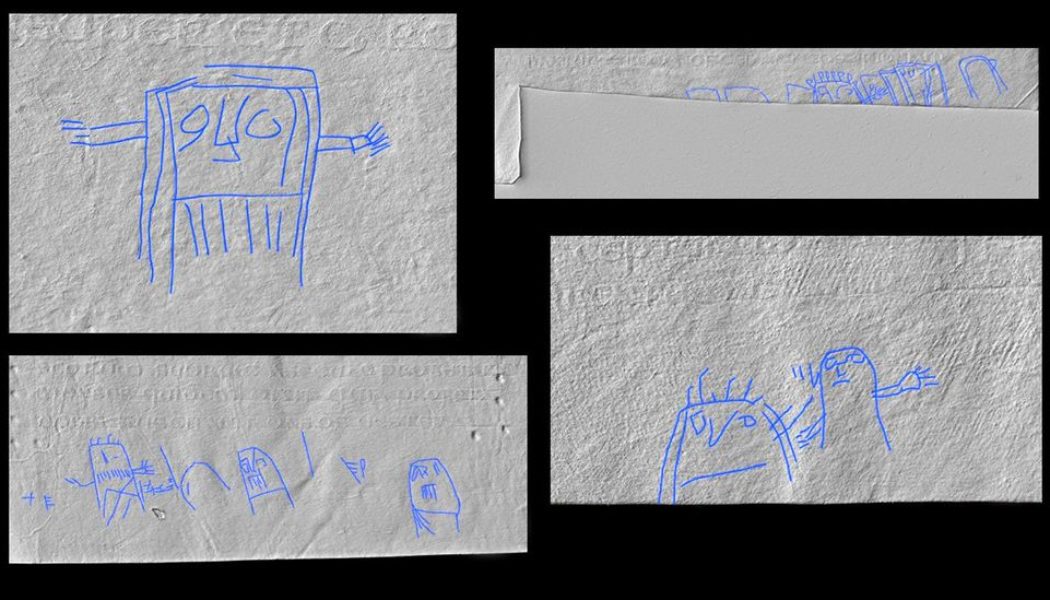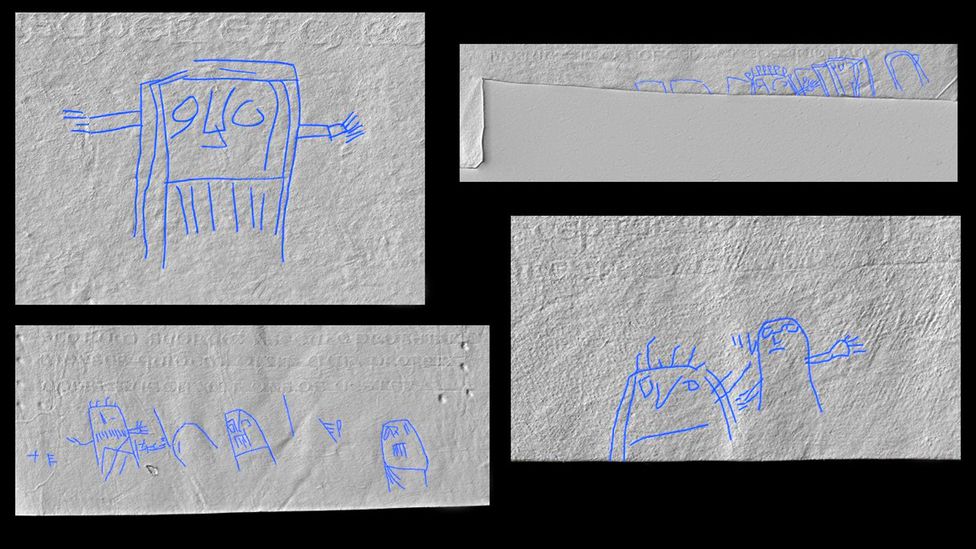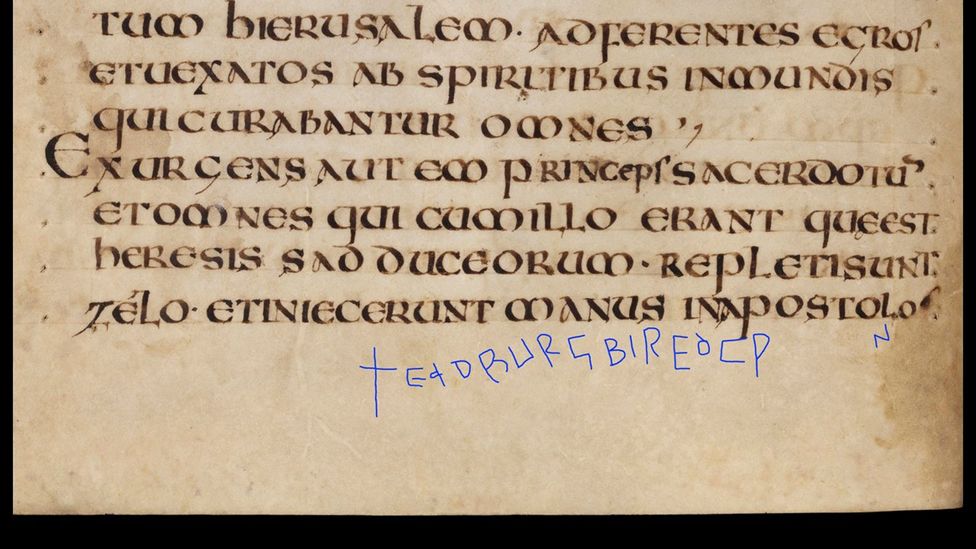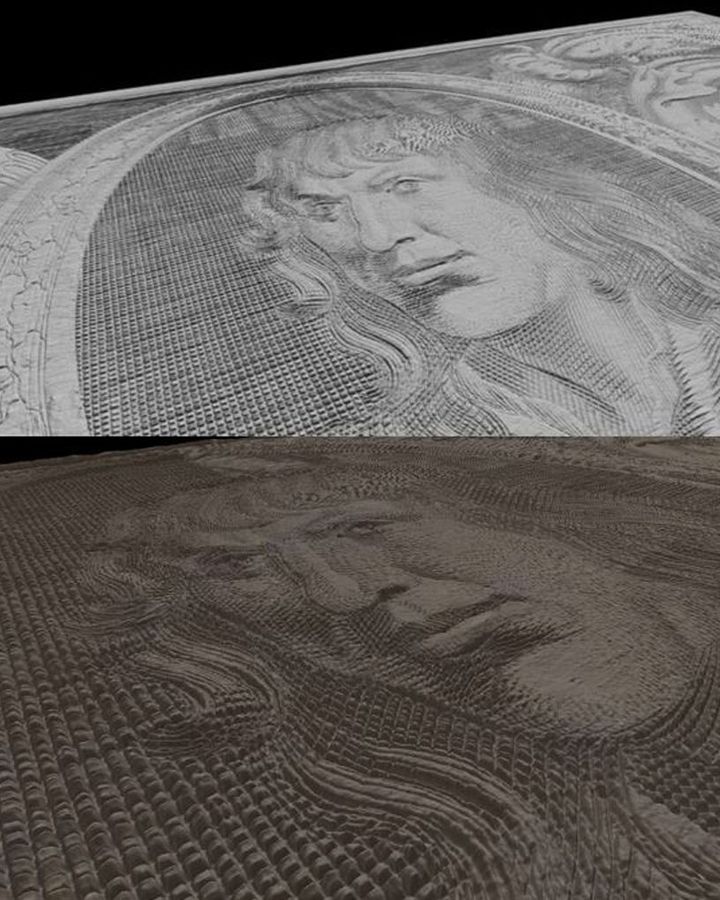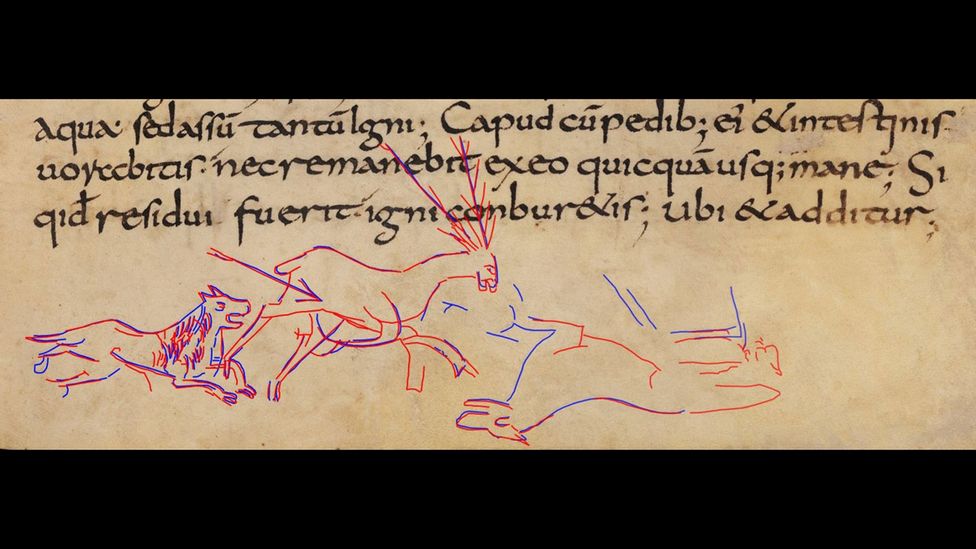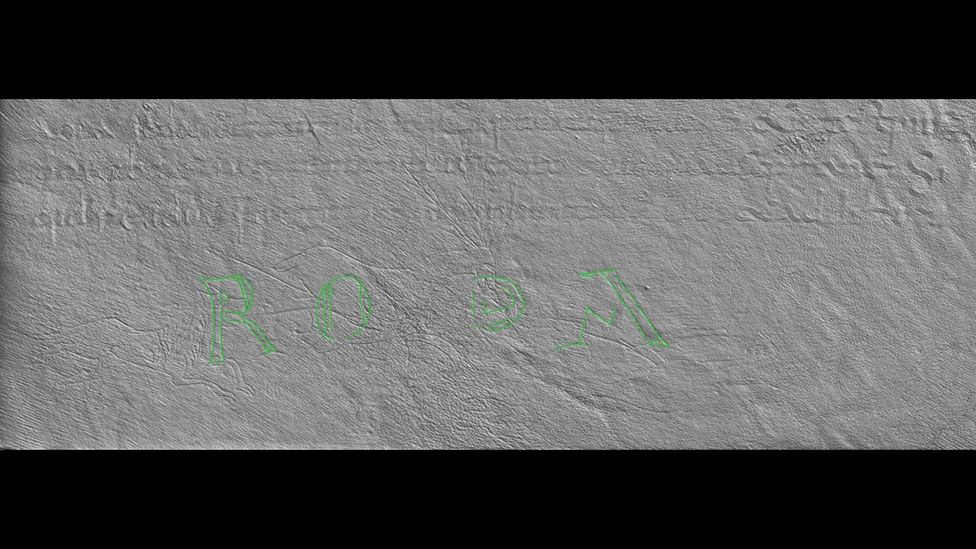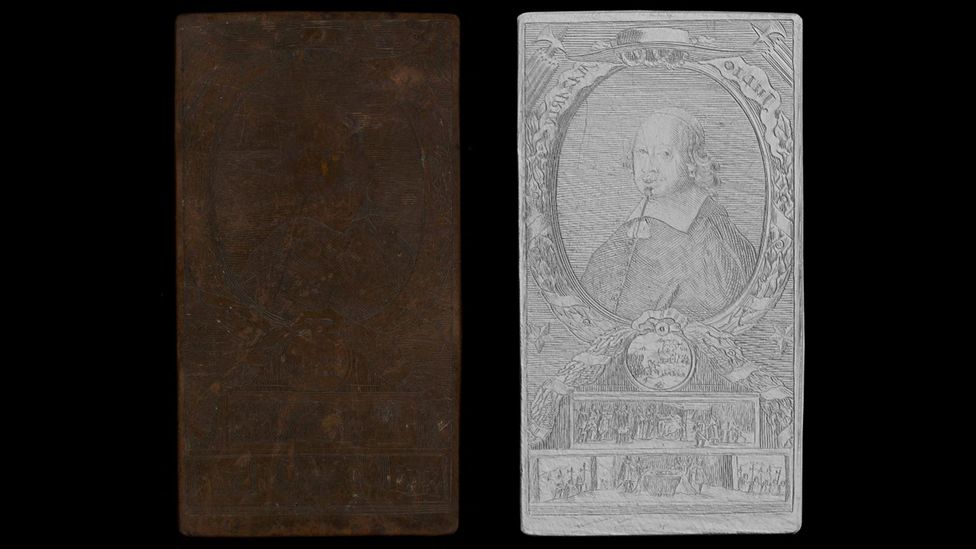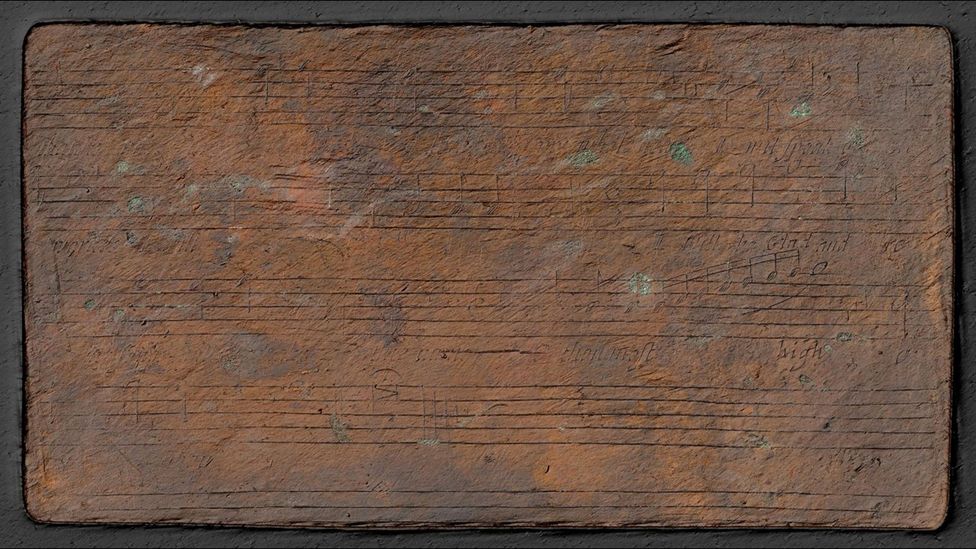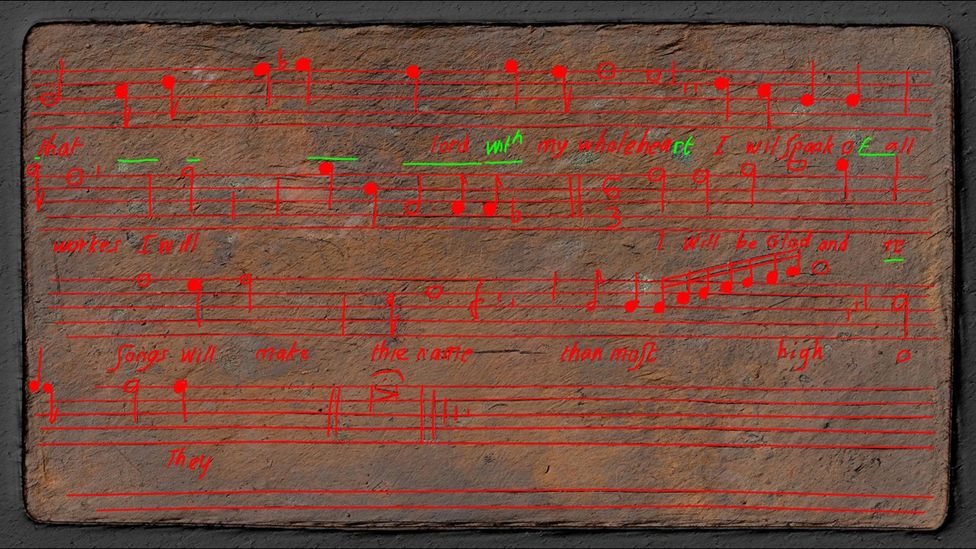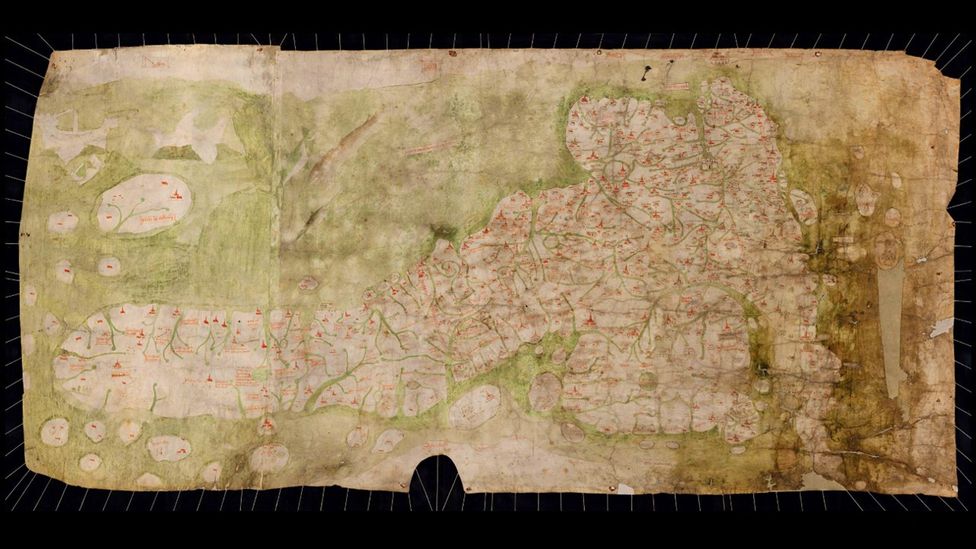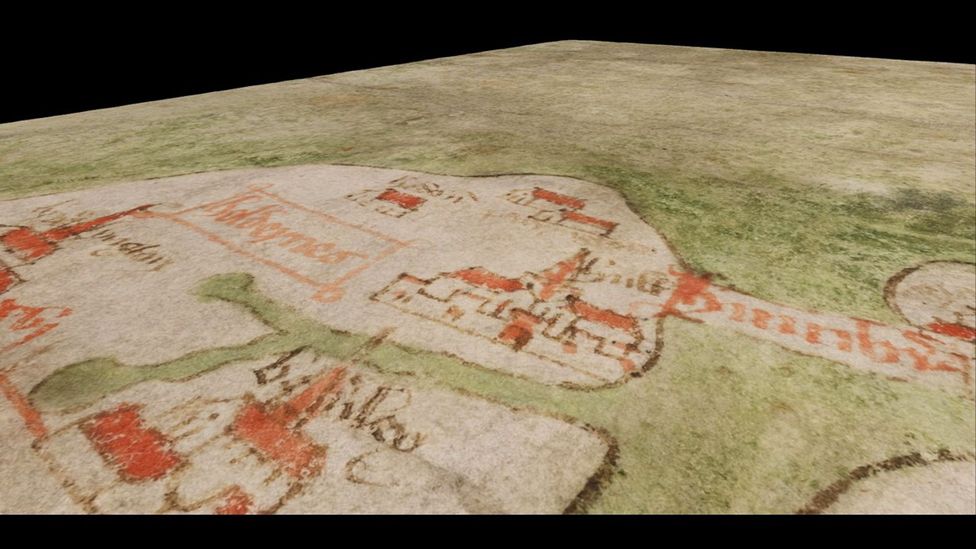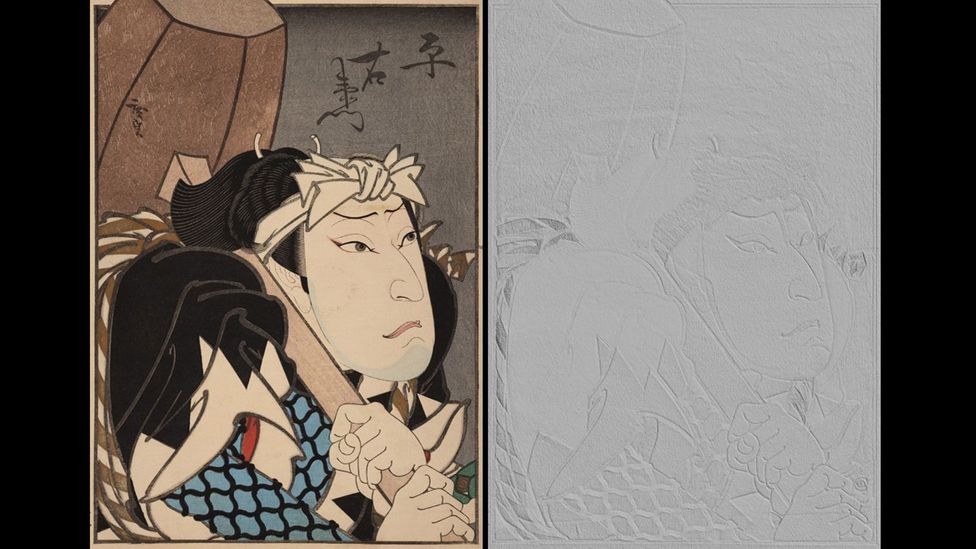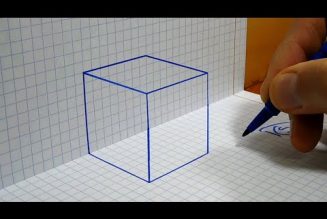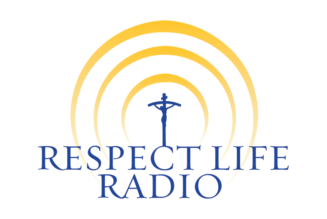Centuries-old books, manuscripts and printing plates often contain invisible etchings, mysterious letters – and even doodles. A new technology that maps the surface of these objects is bringing them to light.
A
Around 1,300 years ago, a woman leant over a precious book, and etched some letters into the margin, along with some cartoonish drawings. She didn’t use ink – she scratched them in, so they were almost invisible to the naked eye.
Until last year, no-one knew they were there.
The 8th-Century book – a copy of the Act of Apostles from the Christian New Testament – is now kept in the Bodleian Library in Oxford. Researchers have known for a while that the religious text was probably owned by a woman, but they weren’t sure who.
In 2022, the researcher Jessica Hodgkinson at the University of Leicester decided to take a closer look, and was surprised to find a hidden etching on page 18, just below the Latin text.
When digitally highlighted, it looked like this:
The letters read: “EaDBURG BIREð CǷ….N”, with the last word incomplete. What could it mean?
Hodgkinson figured that the first symbol was a cross, followed by “Eadburg”: almost certainly the name of the book’s owner. Further analysis revealed it had been scratched deliberately with some form of stylus into four other pages.
Not much is known about her, but Hodgkinson and colleagues suspect that Eadburg was a nun – the abbess of a religious community at Minster-in-Thanet, in the English county of Kent.
The subsequent letters were a bit more enigmatic: could it mean “bears cwærtern” – the Old English word for “prison”? The Latin passage it accompanies describes the imprisonment of the Apostles, so Eadburg might have been drawing a parallel with her own situation.
Even more intriguing, Hodgkinson and colleagues found drawings of little people on other pages. In one margin, a square figure with outstretched arms – could it be a nun perhaps? (see below, top-left). In another, a person holding up their hand to the face of glum companion (bottom-right). An 8th-Century version of “talk to the hand”? Their meaning is a mystery.
The marginalia inside the Eadburg book is not the only example of hidden writing and drawing discovered in Oxford in recent months. Hodgkinson was able to see Eadburg’s etchings thanks to a new imaging technology at the Bodleian Library, which can map the physical texture and contours of a book page, manuscript, or the surface of other historical objects such as printing plates. Doing this in fine detail reveals features that would otherwise be invisible to the eye or standard cameras.
“The surface itself carries a vast amount of information,” explains Adam Lowe, founder of the Factum Foundation in Madrid, a non-profit which engineered the technology for the Bodleian as part of the Archiox project (Analysing and Recording Cultural Heritage in Oxford). “The more you can make that visible, the more really exciting discoveries are going to come out.”
You may also like:
The Archiox researchers use two devices to create digital representations of pages and objects: the “Selene”, which has four cameras capable of capturing differences in surface relief down to 25 micrometres (0.025mm/0.001in), and the “Lucida”, which deploys lasers and two tiny cameras to create 3D scans.
“Everything’s measurable, this is not just an imaging tool, it’s also a measurement tool as well. And that makes it all more exciting,” says John Barrett, the Bodleian’s senior photographer and Archiox technical lead.
In the basement of the Bodleian, the technology is now being used to create digital representations of various items in the library collection.
The Eadburg book was not the only centuries-old document to reveal hidden etchings.
In this 9th-Century manuscript, the Archiox researchers mapped a hunting scene, scratched into the surface:
And then beneath the animals, a name: the letters “RODA”, which probably relate to the book’s owner. “This was never noticed,” says Barrett.
Why would people have etched their names and added drawings like this, almost invisibly?
With the names, it may simply have been to show ownership without scribbling all over a precious religious text. “These manuscripts were considered sacred. And although you wanted to make your own mark on them, you didn’t want to be too obvious necessarily,” explains Barrett.
And as for the pictures, “I don’t think it was necessarily just doodling for the sake of doodling,” he says. “Often with these annotations, and certainly ones that I’ve recorded more recently, they have definitely had a relationship to the text itself.”
Copper plates
Some of the first items in the Bodleian’s collection to be scanned for the Archiox project were 200-to-300-year-old copper printing plates – the Rawlinson collection – selected by Alexandra Franklin, co-ordinator of the Centre for the Study of the Book, and Chiara Betti, a PhD student at the University of London.
Here’s one example where the Archiox technology revealed a previously hidden etching on a plate’s rear. On the front, it depicts an influential French cardinal, but when researchers looked at the back, there appeared to be faint musical staves:
“It was probably inspired by Psalm 9, because the words seem to fit,” says Barrett. In the new King James version of the Bible, Psalm 9 reads: “I will praise you, O Lord, with my whole heart; I will tell of all your marvellous works; I will be glad and rejoice in You; I will sing praise to You name, O Most High.”
Why would someone have done this? “The [copper] material itself was very valuable,” explains Barrett. “It could have been re-used, or it might have just been an opportunity for the artist or the engraver to have a practice.”
However, as he points out, there’s no known print of this music from the plate, so finding it added a new item to historical record. “This has not been marked in the catalogue reference for this plate. These are completely new discoveries being made,” says Barrett. “I would say probably a third of the plates that I’ve imaged for Archiox have had something on the back as well. Very often the designs are really beautiful, or strange or mysterious.”
Maps and artistry
The Archiox technology has also revealed new clues about how objects were crafted, such as the historically important map below.
“This is the earliest recognisable map of the British Isles, dated to the 14th Century,” explains Barrett.
The Archiox team’s imaging of the surface revealed that “it is absolutely riddled in pin holes, over 2,000 of them… features like cathedrals and rivers and things have either been pricked or scored,” says Barrett.
This suggests that some copying had gone on, since map-makers would have used pins to aid duplication by laying the original map on top of the duplication and using the sharp points to score landmarks onto the material below. “You might think that this early map was probably used to generate other maps, but actually, the reverse is true,” he says.
Why so? The surface mapping revealed that “the pin holes don’t go all the way through. So we can deduce from that that this was actually copied from a precursor: an earlier map.”
Finally, the Archiox scanning technology is helping to reveal new insights into the artistry of objects. The Japanese woodblock print below illustrates how. When the Archiox researchers scanned the surface, they noticed that the woodblock artist had added textures that they would have known would have been invisible to the naked eye.
Consider the figure’s face and the bow around his head, both printed using the same colour. See how there’s a difference in texture?
“You wonder, why on Earth, did the printer go to the trouble of doing this really incredible embossing and debossing work, when you can’t appreciate it?” says Barrett. Was it to change the way the light reflected off the finished print? Perhaps. “I think the answer is it was a labour of love. These things were made as perfectly as they possibly could. It gives you a new appreciation of the skill involved in making these things, which you didn’t really have before if you were just photographing them with conventional recording technology.”
Lowe suggests that, through this new approach, there could be thousands of new discoveries waiting to be made, hidden in plain sight in libraries and art collections. “People are starting to realise that ‘relief information’ is transforming our knowledge. There must be objects in libraries all over the world that could benefit from this technology…it’s about treating material objects as evidence,” he says. “There’s a lot that’s known, but there’s a lot more that can be, and I think that’s an incredibly inspiring and exciting thought.”
*Richard Fisher is a senior journalist for BBC Future. Twitter: @rifish
—
Join one million Future fans by liking us on Facebook, or follow us on Twitter or Instagram.
If you liked this story, sign up for the weekly bbc.com features newsletter, called “The Essential List” – a handpicked selection of stories from BBC Future, Culture, Worklife, Travel and Reel delivered to your inbox every Friday.
